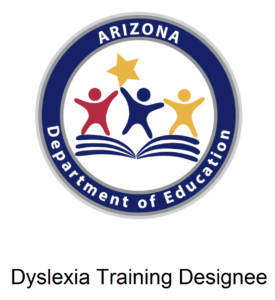Would you like to better understand dyslexia and how it affects students’ reading ability?
There are many reasons why students have difficulty with reading and writing skills. For 10 – 15% of students the cause is dyslexia, a neurobiological learning disability that is characterized by difficulties with accurate or fluent word recognition and poor spelling. This professional development provides the background knowledge about dyslexia that educators need in order to understand why students with dyslexia have difficulty with reading and how to support them in the classroom. Click here to download a printable flyer.
Training Description
This offering totals approximately 6 hours of professional learning time. Topics include:
- What is dyslexia? one type of specific learning disability, dyslexia defined and myths, signs of dyslexia
- The Reading Brain how the brain learns to read, dyslexia and the brain
- Dyslexia and the Five Components of Reading dyslexia and The Simple View of reading, effects of dyslexia on decoding/vocabulary/comprehension, emotional and motivational consequences, accommodations and modifications
- Screening for Dyslexia screening early, screening vs formal diagnosis, suggested screening battery
- Effective Instruction for Students with Dyslexia early intervention, overview of structured literacy instruction, teaching principles including gradual release, explicit and systematic instruction, differentiation, and scaffolding
- Structured Literacy Instruction – Sounds phonemic awareness, basic routines for blending/segmenting, advanced instruction for phoneme manipulation
- Structured Literacy Instruction – Sound-Symbol Correspondences the alphabetic principle, explicit phonics instruction, teaching letter-sound correspondences, phonics scope and sequence, blending and segmenting activities
- Structured Literacy Instruction – Syllable Types six syllable types, syllable division
- Structured Literacy Instruction – Morphemes prefixes/suffixes/roots, combining syllabication with structural analysis to read multisyllable words
There are multiple formats for participating in this professional development, listed below.
Option 1: Live Training
Participate in live training delivered by Keys to Literacy trainers using a virtual-live format (using Zoom meeting software) or onsite at your school district. We will develop a customized professional development plan to meet your scheduling needs.
Option 2: Online Course
A companion Understanding Dyslexia online course is available that takes approximately 6 hours to complete. It covers the same content as live training. It is an asynchronous course, which means users can log on and off multiple times to complete the course assignments at their own pace. Individual educators can register to take the course, or schools can register groups. Contact us to learn more, or register for the course at our Teachable online school.
Option 3: Facilitated-Online Course
This facilitated online option is for educators who would like to complete the online course and also participate in live, debrief sessions facilitated by a Keys to Literacy trainer. These sessions provide a collaborative opportunity to debrief activities completed during the online course, share ideas for connecting course content to classroom instruction, and have the facilitator answer questions and clarify online course content. In addition to the time spent taking the 6 hour asynchronous course, there are two, one-hour facilitated meetings that are scheduled following a flexible schedule that meets the needs of your school district. Click here for a flyer about the facilitated-online option. Contact us to learn more.
Contact Keys to Literacy to learn how to provide this professional development to educators in your school or organization.
State Specific Approved Versions of the Course
 Arizona DOE Approved Version for Dyslexia Designee Training
Arizona DOE Approved Version for Dyslexia Designee Training
A customized version of Understanding Dyslexia has been approved to meet the requirements for Understanding and Recognizing Dyslexia (URD) dyslexia designee training. Click here for more details, or contact us.
 Oregon DOE Approved Version for Dyslexia Training
Oregon DOE Approved Version for Dyslexia Training
A customized version of Understanding Dyslexia has been approved to meet the requirements for Understanding and Recognizing Dyslexia (URD) dyslexia training. Click here for details, or contact us.
Who should participate?
K-5 teachers of any subject, educators who provide support to older, struggling readers, literacy specialists and coaches, and administrators.
